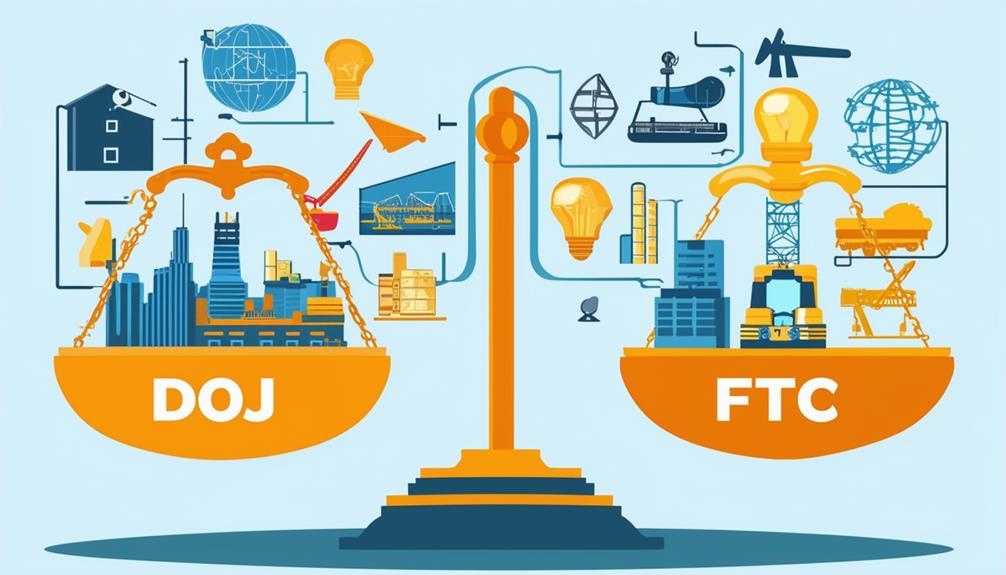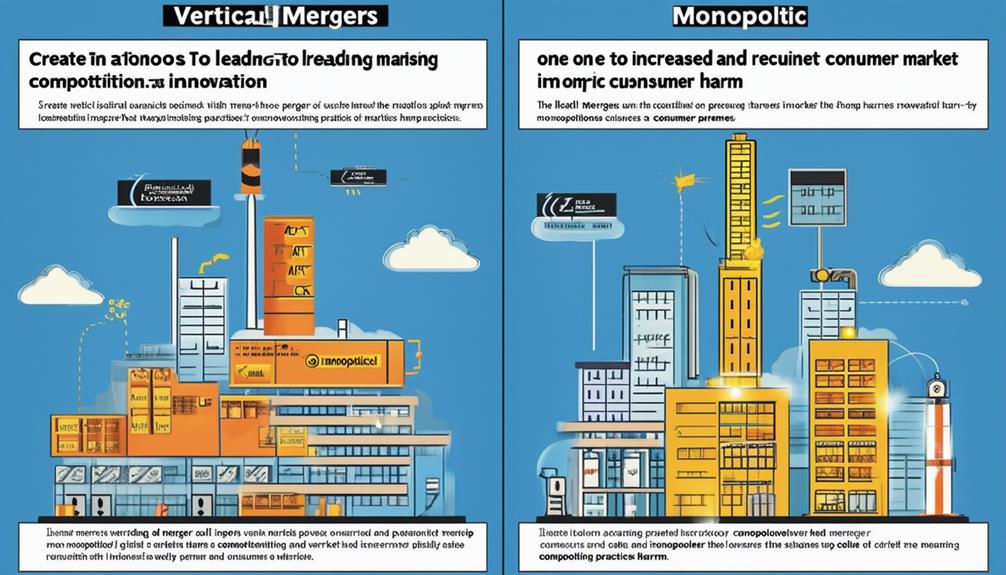Regulatory Considerations for Vertical Mergers

Understanding the regulatory landscape for vertical mergers is crucial for businesses looking to navigate the complexities of antitrust enforcement and compliance requirements. The evolving trends in enforcement by agencies such as the DOJ and FTC, as well as the innovative harm theories put forth by the European Commission, underscore the significance of regulatory considerations in the merger process. By proactively assessing evidence, implementing effective remedies, and devising compliance strategies, companies can enhance their chances of a successful merger while upholding market integrity and fostering fair competition.
In the realm of vertical mergers, it is essential for businesses to stay attuned to the shifting regulatory environment and anticipate the potential challenges that may arise during the merger review process. By proactively engaging with regulators and stakeholders, companies can demonstrate their commitment to compliance and address any concerns that may arise. Additionally, providing clear and compelling evidence to support the merger's benefits and mitigate any potential anticompetitive effects can help expedite the regulatory approval process and pave the way for a smoother integration of the merging entities.
When it comes to implementing remedies for potential anticompetitive issues that may arise from a vertical merger, companies must be proactive and strategic in their approach. Whether through divestitures, licensing agreements, or behavioral commitments, tailored remedies can help address regulatory concerns and facilitate a more seamless integration of the merging companies. By working collaboratively with regulators and stakeholders to develop and implement effective remedies, businesses can not only secure regulatory approval for the merger but also mitigate any potential competitive harm that may arise post-merger.
Compliance with regulatory requirements is a cornerstone of successful vertical mergers. By establishing robust compliance programs and monitoring mechanisms, companies can ensure that they adhere to all relevant antitrust laws and regulations throughout the merger process and beyond. Proactive compliance efforts not only help prevent potential antitrust violations but also foster a culture of integrity and accountability within the merged entity, setting the stage for long-term success in the marketplace.
In conclusion, navigating the regulatory landscape for vertical mergers requires a proactive and strategic approach. By staying informed about enforcement trends, engaging with regulators and stakeholders, implementing effective remedies, and prioritizing compliance, businesses can enhance their chances of a successful merger while promoting market integrity and fair competition. By embracing these regulatory considerations, companies can position themselves for a smooth and successful integration of their operations and maximize the benefits of the merger for all stakeholders involved.
Key Takeaways
Regulatory oversight is essential when evaluating the effects of vertical mergers in the business landscape. It is crucial to consider the impact on market dynamics and competition standards. Compliance requirements can vary depending on the regulatory environment, so it is important for companies to understand and adhere to these regulations to maintain market integrity.
Changes in post-merger incentives can significantly influence how vertical mergers shape the industry. By taking a proactive regulatory approach, authorities can address any potential challenges that may arise from these mergers. This approach helps ensure that competition standards are upheld and that market dynamics remain fair and transparent.
Overall, a focus on maintaining competition standards and market integrity is key when it comes to evaluating and regulating vertical mergers. By staying vigilant and enforcing regulations effectively, regulators can help prevent any anti-competitive behavior and promote a level playing field for all businesses involved in such mergers.
Regulatory Landscape for Vertical Mergers
When examining the regulatory landscape for vertical mergers, we see a significant impact on how benefits are distributed among stakeholders. Regulation plays a crucial role in shaping the outcomes of vertical mergers, especially in industries where compliance requirements are strict. Regulatory oversight is essential to ensure that the effects of vertical mergers on competition are carefully monitored.
In regulated industries, companies involved in vertical mergers must navigate specific compliance requirements, which can result in various types of vertical mergers. Post-merger incentives may also experience significant changes in these environments, ultimately affecting market dynamics. Furthermore, vertical mergers in regulated industries might compel companies to expand their operations in non-vertical ways to comply with regulatory standards.
Understanding the regulatory framework surrounding vertical mergers is vital for stakeholders to grasp the complexities and implications of such transactions. By exploring the intricacies of regulation in vertical mergers, we can gain a better understanding of how benefits are distributed and the broader impact on the industry landscape.
Antitrust Enforcement Trends in Vertical Mergers
In 2022, the DOJ and FTC took a notable step by filing 9 complaints challenging mergers, showcasing a growing emphasis on litigating vertical merger trials. This shift reflects the current trends in antitrust enforcement, where regulators are broadening their scope beyond traditional concerns to address potential antitrust issues arising from vertical mergers in various sectors.
The European Commission (EC) has also been proactive in this space, introducing innovative theories of harm in vertical merggers, including a unique concept focusing on the loss of innovation. This indicates a willingness to explore new avenues for evaluating the impact of vertical mergers on competition and consumer welfare.
Both US and EU regulators are now prioritizing global coordination efforts to ensure a cohesive approach to vertical merger enforcement. Interestingly, the EU appears to be more open to considering behavioral remedies in vertical merger cases, signaling a shift towards a more flexible and nuanced approach to addressing antitrust concerns.
Recent policy changes, such as the revision of Merger Guidelines and the withdrawal of the 2020 Vertical Merger Guidelines, demonstrate a more assertive stance by the DOJ and FTC towards enforcing antitrust laws in the realm of vertical mergers. These developments highlight the evolving landscape of antitrust enforcement, as regulatory agencies adapt their strategies to tackle the emerging challenges posed by vertical mergers.
DOJ and FTC Challenges in Vertical Mergers

We've noticed a shift in the approach of the DOJ and FTC when it comes to vertical mergers. They've become more proactive in challenging such mergers, as seen in their legal battles against 9 mergers this year. Despite facing some setbacks, both agencies remain steadfast in their dedication to examining mergers beyond the usual antitrust concerns.
Significant cases like Metas' acquisition of Within and Illumina's purchase of GRAIL have caught the attention of the FTC, showcasing the heightened efforts of these agencies in maintaining competition standards.
Antitrust Concerns Addressed
Vertical mergers have garnered increased attention from the Department of Justice (DOJ) and Federal Trade Commission (FTC) in recent years. In 2022 alone, 9 complaints were filed, signaling a shift towards more assertive litigation strategies. Antitrust concerns in vertical mergers are now being scrutinized more extensively, with regulators exploring innovative theories to address potential harm.
Regulators are broadening their assessment criteria beyond the withdrawn 2020 Vertical Merger Guidelines. This necessitates a more thorough antitrust analysis that takes into account a wider range of potential impacts. The focus isn't just on the immediate effects of the merger but also on its long-term consequences on market competition and innovation.
The European Union's (EU) inclination towards behavioral remedies in vertical merger reviews marks a departure from traditional approaches. By addressing concerns like the loss of innovation theory, regulators are aiming to mitigate antitrust risks effectively. This shift reflects a proactive stance towards fostering a competitive and innovative market environment.
The evolution of harm theories in antitrust evaluations is evident in the incorporation of concepts like the raising rivals' cost theory. This dynamic approach showcases a commitment to promoting competition and innovation in rapidly evolving markets. By embracing these new theories and strategies, regulators are better equipped to safeguard market dynamics and prevent potential anticompetitive behavior in vertical mergers.
Impact on Competition
The Department of Justice (DOJ) and Federal Trade Commission (FTC) are ramping up their scrutiny of vertical mergers by filing 9 complaints in 2022, indicating a shift towards more aggressive litigation strategies. This increased focus on competition arises from concerns about the potential negative impact on market competition that could result from vertical mergers. By challenging these mergers, the agencies seek to maintain a level playing field and safeguard consumers from unfair practices. High-profile cases such as Meta's acquisition of Within and Illumina's merger with GRAIL have encountered regulatory hurdles, underscoring the agencies' commitment to addressing antitrust issues in the vertical merger arena.
The proactive stance taken by the DOJ and FTC underscores a broader dedication to preserving competition in the marketplace and upholding antitrust laws in the realm of vertical mergers. The regulatory challenges faced by companies engaging in vertical mergers highlight the agencies' resolve to ensure fair competition and protect consumer interests. This assertive approach reflects a commitment to preventing potential harm to competition and promoting a competitive landscape that benefits consumers.
Regulatory Scrutiny Analysis
In 2022, the Department of Justice (DOJ) and Federal Trade Commission (FTC) have ramped up their scrutiny of vertical mergers, challenging the merger landscape to uphold market competition. This heightened focus on vertical mergers has resulted in a more rigorous evaluation process by regulators.
- Focus on Trial Challenges: The DOJ and FTC have filed 9 complaints in 2022, indicating a shift towards increased trial challenges for vertical mergers. This shift demonstrates a commitment to thorough scrutiny and a readiness to contest mergers that could hinder market competition.
- Prominent Merger Challenges: High-profile mergers such as Meta's acquisition of Within and the Illumina/GRAIL merger have encountered challenges from the FTC. These notable cases showcase the agencies' resolve to address potential anticompetitive effects in vertical mergers.
- Policy Revisions and Assertive Approach: Recent policy adjustments, including the withdrawal of the 2020 Vertical Merger Guidelines and the introduction of updated Merger Guidelines, reflect a more assertive regulatory approach towards vertical mergers. This proactive stance underscores the significance of preserving market dynamics and innovation through regulatory oversight.
European Commission's Approach to Vertical Mergers
When it comes to vertical mergers, the European Commission has a distinctive approach that sets it apart in the Mergers and Acquisitions landscape. The EU Vertical Merger Guidelines, Market Definition Criteria, and Vertical Restraints Assessment play a pivotal role in shaping the Commission's evaluation process. For companies looking to navigate vertical mergers in the European market, understanding how these factors influence the Commission's perspective is crucial.
The European Commission's unique considerations in vertical mergers reflect a comprehensive framework designed to ensure fair competition and market efficiency. By incorporating the EU Vertical Merger Guidelines, the Commission aims to evaluate the potential impact of vertical mergers on competition, innovation, and consumer welfare. This approach helps in assessing whether a proposed merger could lead to anti-competitive behavior or harm consumer interests.
Moreover, the Market Definition Criteria utilized by the European Commission provide a structured analysis of the relevant market affected by a vertical merger. By delineating the boundaries of the market and identifying key players, the Commission can assess the potential effects of the merger on competition within that market. This analytical tool enables the Commission to make informed decisions based on market dynamics and competitive forces at play.
In addition, the Vertical Restraints Assessment conducted by the European Commission focuses on evaluating any vertical agreements or restrictions that may arise as a result of the merger. By examining the potential impact of such restraints on competition and consumer choice, the Commission aims to prevent any anti-competitive practices that could distort the market. This proactive approach helps in safeguarding the interests of both businesses and consumers in the European market.
EU Vertical Merger Guidelines
The European Commission's guidelines on vertical mergers address potential anticompetitive effects, focusing on concerns like foreclosure, raising rivals' costs, and coordination. When considering these guidelines, it's important to understand the delicate balance they strike between allowing firms to achieve efficiencies through integration and preventing harm to competition. By evaluating the impact on foreclosure and raising rivals' costs, regulators aim to maintain a competitive market landscape that fosters innovation.
Vertical mergers can both promote innovation and pose risks to competition, and the guidelines emphasize the need to safeguard innovation while ensuring fair market dynamics and consumer choice. Regulators assess how these mergers may affect competition levels to create a level playing field for all market participants.
In cases where competition concerns arise from vertical mergers, the guidelines empower regulators to prescribe remedies to mitigate anticompetitive effects. These measures help create a healthier competitive environment that encourages ongoing innovation and benefits consumers.
Market Definition Criteria
When examining vertical mergers, the European Commission focuses on defining relevant product and geographic markets using specific criteria. The Commission analyzes the competitive constraints faced by the merging companies and their competitors in both the upstream and downstream markets. Factors like customer preferences, substitutability, and market dynamics play a crucial role in outlining the boundaries of the affected markets.
Vertical Restraints Assessment
When assessing vertical mergers, our focus shifts to examining vertical restraints to prevent anticompetitive effects, particularly scrutinizing potential harm to competition in the European Commission's approach.
The European Commission meticulously analyzes the impact of vertical restraints on market dynamics, with a keen eye on fostering competition and innovation within affected markets. Potential harm to competition is a key consideration, as the EC aims to safeguard consumer welfare and maintain a level playing field for market participants post-merger.
In cases where concerns arise, the EC may explore behavioral remedies as a way to address anticompetitive effects and promote a healthy competitive environment.
Emerging Theories of Harm in Vertical Mergers

In vertical mergers, the evolving concerns extend beyond traditional competition issues to include worries about potential stifling of innovation. Regulators are now paying more attention to the risks of antitrust violations in vertical mergers, especially when dominant market players acquire innovative startups.
To tackle these challenges, regulators are exploring behavioral remedies such as interoperability requirements and commitments to prevent data silos. This shift towards considering behavioral remedies mirrors a global trend, with regulators worldwide showing greater willingness to embrace such measures, particularly in cases where data-related issues are prominent.
The increased focus on enforcing vertical mergers in innovation-driven industries is poised to influence regulatory approaches globally, underscoring the need to strike a balance between competition concerns and the advancement of innovation in merger evaluations.
Extended Regulatory Reviews for Vertical Mergers
In the current regulatory landscape, our regulators are engaging in extensive reviews of vertical mergers under the Biden administration. This shift challenges the traditional notion that 'big is bad' and underscores the increased scrutiny being placed on mergers across various sectors. The focus is on ensuring fair competition and preventing any potential harm to consumers.
One key implication of these extended regulatory reviews is the enhanced emphasis on antitrust enforcement. Regulators are ramping up their efforts to assess the competitive impact of vertical mergers, signaling a more robust stance on antitrust regulations.
Moreover, there's a heightened emphasis on regulatory scrutiny surrounding vertical mergers. Regulators are delving deeper into understanding the potential consequences of these mergers on market dynamics and consumer welfare, aiming to maintain a level playing field in the marketplace.
In response to concerns raised by vertical mergers, regulators are exploring the effectiveness of behavioral remedies to address any anticompetitive behaviors and uphold market integrity. This proactive approach reflects a commitment to fostering a competitive marketplace while ensuring that vertical mergers comply with regulatory standards and don't impede fair competition.
Divergent Outcomes in Vertical Merger Cases

Different regulatory approaches and interpretations can result in varied outcomes in vertical merger cases, impacting how antitrust harm is perceived. Global regulators, like the EU and US, may have differing views on the competitive effects of vertical mergers, which can shape their analyses and decisions. The use of behavioral remedies and the application of distinct legal frameworks also play a significant role in addressing concerns related to vertical mergers, underscoring the intricate and multifaceted nature of these regulatory considerations.
In the realm of mergers and acquisitions, the perspectives of regulators can heavily influence the outcomes of vertical merger cases. For instance, the EU often emphasizes the importance of market competition and consumer welfare when assessing such mergers, while the US may focus more on potential efficiencies and innovation benefits. These contrasting viewpoints can lead to divergent approaches in evaluating the antitrust implications of vertical mergers, ultimately affecting the regulatory decisions made by each jurisdiction.
Behavioral remedies, such as imposing certain conditions on the merged entities to mitigate competition concerns, are frequently utilized in vertical merger cases. By requiring specific actions or constraints from the merging parties, regulators aim to address potential anticompetitive effects while still allowing the merger to proceed. This approach reflects a nuanced understanding of the complexities involved in vertical mergers and demonstrates a proactive effort to safeguard market dynamics.
Furthermore, the application of unique legal frameworks in different regions can also contribute to the varying outcomes seen in vertical merger cases. For example, the EU's strict enforcement of competition laws under the Treaty on the Functioning of the European Union (TFEU) contrasts with the more flexible approach taken by US antitrust authorities under the Sherman Act. These differences in legal standards and enforcement mechanisms can result in disparate evaluations of vertical mergers, highlighting the importance of considering jurisdiction-specific regulations in such cases.
Case Analysis Differences
In the realm of analyzing competitive effects in vertical merger cases, regulatory decisions can significantly differ, showcasing the intricate considerations of each specific situation. When delving into the disparities in case analysis within vertical merger enforcement, several crucial points emerge:
- Diverse Factors Evaluated: Regulators may assess varying factors in each vertical merger case, including market concentration, potential efficiencies, and entry barriers. This diversity in considerations often leads to a range of regulatory decisions and enforcement actions tailored to the unique circumstances of each case.
- Intricate Anticompetitive Effects: The varied outcomes in vertical merger cases highlight the importance of conducting a detailed examination of potential anticompetitive effects unique to each case. The complexity of vertical mergers necessitates a thorough investigation by regulators to accurately gauge the impact on competition.
- Customized Remedies: The distinct features of individual vertical merger cases contribute to the variability in regulatory decisions and remedies implemented. Crafting enforcement actions to address specific concerns identified in each case allows for more targeted regulation, fostering competition in the market.
Regulatory Impact Variations
When exploring regulatory impact variations in vertical merger cases, the outcomes often differ significantly due to the unique approaches taken by jurisdictional regulators. These variations can have a substantial impact on deal agreements and timelines, as different antitrust agencies analyze vertical mergers through their own lenses.
For instance, EU regulators prioritize specific legal frameworks and behavioral remedies in their evaluations, while US regulators, particularly under the Biden administration, take a stance of challenging mergers across various sectors with a focus on the idea that 'big is bad'.
The collaboration among regulators globally is increasing, yet outcomes may still vary, especially regarding the acceptance of behavioral remedies. This evolving landscape highlights the complexity of addressing regulatory considerations in vertical mergers, where grasping the subtleties of different regulatory environments is crucial for achieving successful deal outcomes.
As vertical mergers continue to reshape industries, staying informed about regulatory impact variations is essential for companies looking to innovate and expand within this dynamic regulatory framework.
Addressing Concerns in Vertical Mergers
When looking at vertical mergers, regulators must carefully analyze the potential impact on market competition and innovation. It's crucial to strike a balance between efficiency gains and the risk of anticompetitive behavior to ensure a fair marketplace. To effectively address concerns in vertical mergers, regulatory bodies should follow these key steps:
- Thorough Evaluation: Start by conducting a comprehensive assessment of how the merger could affect competition, entry barriers, and innovation. This evaluation should consider risks like foreclosure, raising rivals' costs, and collusion, which could stifle competition and innovation in the market.
- Efficiency Assessment: Take a close look at the efficiencies that the merger might bring, such as cost savings, better coordination, and innovation benefits. Understanding these potential gains is essential in determining whether they outweigh any negative effects on competition that could result from the merger.
- Continuous Scrutiny: It's important to maintain ongoing regulatory scrutiny to prevent the expansion of market power and ensure that competition remains strong post-merger. This ongoing oversight is vital for protecting consumer interests and fostering a competitive market environment in the wake of vertical mergers.
Evidence Requirements in Vertical Merger Reviews

Robust evidence is crucial for regulators to evaluate the competitive impact of vertical mergers. In vertical merger assessments, it's important to present evidence that highlights either potential anticompetitive effects or efficiencies that benefit consumers. Evidence requirements in vertical merger reviews include data on market shares, entry barriers, and customer switching costs. Moreover, conducting quantitative analysis on price effects, innovation incentives, and foreclosure risks can significantly assist in evidence-based decision-making. Economic models and industry data serve as valuable tools for regulators to understand the effects of vertical mergers on market dynamics.
Market shares are a key aspect of the evidence needed in vertical merger reviews, showing market dominance or changes in market concentration. Understanding entry barriers is also essential, providing information on the hurdles that new competitors face when trying to enter the market. Additionally, data on customer switching costs can illuminate the expenses customers incur when switching between products or suppliers. Quantitative analysis, such as examining price effects, innovation incentives, and risks of foreclosure, helps paint a clearer picture of the potential outcomes of vertical mergers on competition and consumer welfare.
Remedies for Antitrust Issues in Vertical Mergers
When dealing with antitrust issues in vertical mergers, the key is to implement effective remedies that can address potential harms and foster competition. Regulators typically consider the following strategies to strike a balance between anticompetitive effects and procompetitive efficiencies:
- Divestitures: Divestitures entail selling specific assets or divisions to restore competition that might've been impacted by the merger. This remedy is aimed at creating a fairer playing field for other competitors in the market.
- Behavioral Commitments: Regulators may impose behavioral commitments on the merging parties to deter anticompetitive practices. These commitments could include clauses on non-discrimination or access provisions to uphold fair competition.
- Licensing Agreements: In certain instances, regulators might mandate the merging companies to engage in licensing agreements to ensure equitable access to essential technologies or resources. These agreements can help sustain a competitive environment within the relevant markets.
Compliance Strategies for Vertical Mergers

To ensure compliance with regulatory requirements in vertical mergers, companies need to focus on assessing and addressing potential antitrust risks linked to integrating different stages of the supply chain. Understanding the regulatory environment and seeking legal guidance are crucial steps in navigating the complexities of compliance programs for vertical mergers. By implementing strong compliance measures and conducting thorough due diligence, companies can avoid regulatory hurdles and enforcement actions post-merger.
For companies involved in vertical mergers, it's important to proactively engage with regulators and stakeholders to tackle concerns regarding competition, market access, and consumer protection. This proactive stance showcases a dedication to compliance and promotes transparency and trust throughout the merger process. By staying abreast of the changing regulatory landscape and consistently evaluating antitrust risks, companies can devise effective compliance strategies that align with industry standards. Prioritizing compliance in vertical mergers is essential for ensuring a seamless integration process and sustainable business expansion.
Frequently Asked Questions
What Are Vertical Merger Guidelines?
Vertical merger guidelines serve as a valuable tool in assessing mergers within the business landscape. These guidelines offer a structured approach to analyzing the impact of vertical mergers on market efficiency, consumer welfare, supply chain dynamics, and competition within an industry. By providing a framework for evaluating the effects of vertical integration on competition and innovation, these guidelines help regulators and businesses make informed decisions.
In the realm of mergers and acquisitions, understanding the implications of vertical integration is crucial. It allows stakeholders to assess the potential benefits and risks associated with merging companies that operate at different stages of the supply chain. By considering factors such as economies of scale, market power, and potential barriers to entry, vertical merger guidelines aid in determining the overall impact on competition and market dynamics.
Historically, vertical mergers have been scrutinized for their potential to stifle competition and harm consumers. By following established guidelines, regulators can identify and address anticompetitive concerns while also recognizing the potential efficiencies that may arise from such mergers. This balanced approach aims to promote a competitive marketplace while also fostering innovation and economic growth.
Are There Laws Against Vertical Integration?
Vertical mergers pose challenges due to antitrust concerns, the potential for market dominance, and regulatory obstacles. Laws addressing vertical mergers aim to prevent anticompetitive practices and protect consumers, with regulatory bodies closely monitoring for any signs of violations.
Vertical mergers involve the integration of companies operating at different stages of the supply chain, such as a manufacturer acquiring a distributor. This type of merger can lead to increased efficiency, streamlined operations, and potentially lower costs for the merged entity. However, there is a fine line between beneficial integration and anticompetitive behavior.
Antitrust laws are in place to ensure fair competition in the market and prevent companies from abusing their market power. When assessing vertical mergers, regulators consider factors such as the potential for foreclosure of competitors, increased barriers to entry for new players, and the impact on consumer choice and prices.
Enforcement agencies like the Federal Trade Commission (FTC) and the Department of Justice (DOJ) play a crucial role in scrutinizing vertical mergers to determine their potential effects on competition. Through thorough investigations and sometimes legal challenges, these agencies aim to maintain a level playing field in the market and protect consumers from harm.
In recent years, there have been several high-profile cases where vertical mergers faced regulatory scrutiny, such as the AT&T-Time Warner merger and the CVS-Aetna merger. These cases highlight the importance of balancing the potential benefits of integration with the need to safeguard competition and consumer welfare.
Are Vertical Mergers Regulated by the Sherman Act?
Vertical mergers fall under the purview of the Sherman Act, which aims to ensure a level playing field in the marketplace, encourage efficiency in business operations, maintain options for consumers, and address concerns related to monopolistic practices. Companies must abide by these regulations when engaging in mergers to navigate the process successfully.
Regulated by the Sherman Act, vertical mergers are subject to scrutiny to prevent any anti-competitive behavior that could harm market competition or consumer choice. By adhering to these regulations, businesses can uphold fair market practices and prevent monopolistic tendencies that may arise from mergers.
What Are the Problems With Vertical Mergers?
Vertical mergers present significant challenges such as creating barriers to entry and facilitating collusion. These mergers have a substantial impact on competition and market dynamics, especially in sectors like telecommunications and computers. Assessing the efficiencies in such mergers can be a complex task.
Conclusion
Vertical mergers are under increasing scrutiny by antitrust authorities worldwide. Recent data reveals that vertical mergers constituted more than 30% of all merger transactions in the previous year.
It's crucial for companies involved in vertical mergers to carefully navigate regulatory considerations, address potential antitrust issues, and implement compliance strategies to ensure a seamless and successful merger process. Staying informed and proactive in this complex regulatory environment is key to achieving a successful outcome.





